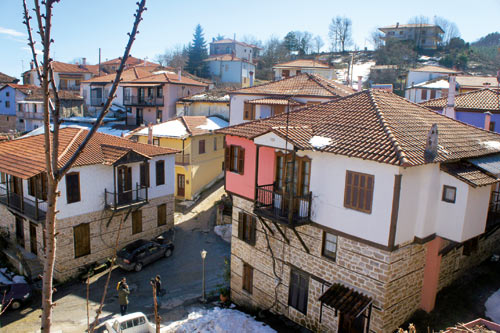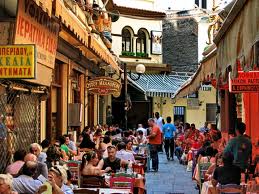![]()
2013
Greece Turkey
Macedonia
Tour
Journal
19, 20, 21
September, 2013 Thessaloniki
22 September, 2013 Makrigilio
Click Here for
Makrigilos, Litohoro,
Mount Olympus, Enipea Canyon, Dion
September 23, 2013
September 20, 2013 Friday Thessaloniki
We got to sleep in. We left
the hotel at 09:30. the streets were starting to get crowded. The wind
was blowing from the north - the Vardar wind. We were all surprised how
cold it was compared to the day before. the museum was across the corner
from our hotel. The pleasant surprise was the very efficient and simple
elevator which Colin and Mary used successfully. The
first room of the museum was dedicated to the "gold in the Ancient
World. Not only was gold used as symbol of wealth, funeral gifts, but on
daily basis gold was always in demand.
An illustration on a vase gave us an idea of how men, women and children work in the gold mines to supply the market for this great demand. another illustration on a vase showed s man giving gift to his beloved.
The golden diadems for the victors of the games and the gold leaf ornaments for the women's dresses were all ornamented in great detail.
The
exhibition in the other halls went in a chronological order starting
from the iron age. This time I wanted to emphasize on the peoples of
different ages. The various statues and statuettes of male and female
once again showed that there were not much difference from what we have
today. Some
were more happy
than the others. Some were beautiful while the others were not as
attractive . The gold
gilded bronze images of the deities were in perfect condition.
Being able
to see the body language of these figures and seeing the emotions
bursting out from their eyes is thrilling. After
a wonderful well deserved coffee break, we started driving through the
narrow streets of the old city to the acropolis
of the city. The Ottomans had conquered this port in 1430 while the city
was under the rule of the
Venetians. Until 1912 Thessaloniki prospered
as an Ottoman city.
 At
the very top of the city walls which were going down to the sea, there
were seven towers and was called Yedi Kule
( in Turkish meaning The Seven Towers.) It was sad that nothing of the
500 year old past of the city was left. You could not see one minaret in
sight.
At
the very top of the city walls which were going down to the sea, there
were seven towers and was called Yedi Kule
( in Turkish meaning The Seven Towers.) It was sad that nothing of the
500 year old past of the city was left. You could not see one minaret in
sight.
 Our
next stop was one of the biggest churches of the Byzantine Era.
the Ottomans had converted the church to a
mosque
and kept the beautiful
mosaics and
the Byzantine frescoes. After
1912, the Mosque this time was converted back to a church. the
foundation of the church was a roman edifice. Not much of the Roman
construction was excavated, but the Byzantine torture rooms, chapels and
baptistery were all intact. We all admired the timelessness of the
building.
Our
next stop was one of the biggest churches of the Byzantine Era.
the Ottomans had converted the church to a
mosque
and kept the beautiful
mosaics and
the Byzantine frescoes. After
1912, the Mosque this time was converted back to a church. the
foundation of the church was a roman edifice. Not much of the Roman
construction was excavated, but the Byzantine torture rooms, chapels and
baptistery were all intact. We all admired the timelessness of the
building.
After a wonderful home made like lunch , we all walked to the Bezistan - a Turkish word meaning the land of the textiles . Since my grand father was a merchant of material and wonderful textiles, I thought he must have had a shop in Bezistan. It is a very strange feeling to be at a place where my grand mother must have bought material to saw outfits for my aunts and uncles. Since the afternoon was free, every one went their own way and I ended up buying few more of my favorite curtains. I had promised every one in the group to take them to my favorite fish restaurant, but I found out that like many other business in Greece, this restaurant had been closed for a while. so at night we had to find another fish restaurant. The food was great, the ambiance was wonderful but the services droved every one crazy. to get a glass of wine we had to call the waiter three times. The end of the day was nice. We walked to the hotels.
September 21,
2013 Saturday, Thessaloniki
Mount Athos, Oronopolis
We
left the hotel at 08:00 am. The morning traffic was just starting to get
busy even on a Saturday morning. We started heading east. Then we turned
north and hit the mountains. Soon we left the big highway behind and
started going on the winding mountain road. The tops of the mountains
were covered with forests. After a short coffee break we arrived in
Oronopolis. The Russian tourists favorite town was waking up to a warm,
sunny day. When we all boarded our boat, most of the seats were already
taken. There were a few nuns who looked like a dramatic contrast to the
Russian tourists who were barely wearing any thing. These nuns who had
devoted their lives for the very same thing that the monks of Mount
Athos did, were not allowed to put their foot in the Mount Athos
monasteries. I wondered if they were thinking that this was not
fare or if they did not care. I wish I could ask them. Once the boat
started moving we were surrounded with sea gulls who followed us for 3
hours. Actually against t he blue color of the sea, the sea gulls looked
very beautiful. The earliest monastery was built in the 9th century.
The monasteries have been an
autonomy during the Ottoman period. No females are allowed in the
peninsula. the most crowded monastery is the Russian Orthodox monastery
with 30 people living in it. At times there were up to 2000 monks in
each one of them. Al of them with slight different architecture, sit on
the edge of the mountain as if they are resisting the time. No
electricity, no running water and seemed like soon there will be no
monks left.
When we
returned to Thessaloniki, we visited the house of our guide , Athena.
Her mother had prepared wonderful borek for us and served us walnut
liquor.
The collection of woven table cloths that Athena's grand ma made was a
joy for our eyes. the most popular person was Athena's daughter Maria.
Maria is a gymnast and she shared with us many of her medals and her
photos of her big contest.


September 22, 2013 Sunday, Pella, Vergina, Makrigilos
We did not
leave the hotel until 09:30. the north wind was blowing and once again
we felt the cold air. We walked on the main road for two blocks and
stopped at the 2nd Century AD monument built by a roman Emperor, Galius.
He had his palace built by the Sea and a road connecting the tomb that
he built for himself, the built an arch faced with marble reliefs'
telling the story of his life. The round building which was meant to be
his tomb, was used as a church until the turks took the city in 1430. A
minaret was added. the mosaics were white washed and protected. After
1912, the mosque was converted back to be a church. The service is held
on only special days. The grandeur of the building is breath taking.
We visited the house of Mustafa Kemal Ataturk. Unfortunately, after the recent restoration , the house looked more like a gallery than a house. Mustafa Kemal and his family had to leave the house in 1912, when the city was handed over to the Greeks. A rich orthodox family from Trabzon had bought the house when they ended up in Thessaloniki after the enforced migration. After the republic of Turkey was established Venizelos of Greece and Mustafa Kemal had shaken hands with each other and decided to forget the war which actually was the result of the provocation of the British. due to their friendship, when on the 10th of November 1938 Mustafa Kemal had died, Venizelos had given the pink house where Mustafa was born to the Turkish State.
Pella where Alexander the great was born
Demostanes gave us a wonderful presentation on Textile archaeology
Click Here
for
Makrigilos, Litohoro,
Mount Olympus, Enipea Canyon, Dion
September 23, 2013